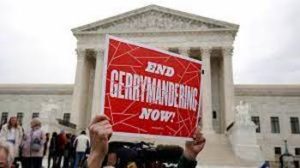
*Black History and Gerrymandering voting districts are affirmed on this date in 1812. The word appeared for the first time on this date in the Boston Gazette newspaper.
Gerrymandering and its focus on voter suppression began with the passage of the 15th Amendment to the US Constitution. The return of Blacks to Congress after Reconstruction and their expansion in the fourth generation intervened in the courts with legislative remedies. Court decisions supported the creation of majority or minority congressional districts. These developments included the Great Migration.
The US House of Representatives elects only one member from each district. Such a system can make it hard for minority groups to gain representation. For instance, if African Americans are spread out throughout a state, they might not have enough in any district to elect representatives.
Many US states deliberately brought about this outcome in the past, drawing their maps to ensure whites would win every district. That’s a process known as racial gerrymandering. The federal government addressed this in the Voting Rights Act of 1965, which made it illegal to draw districts that intentionally dilute the voting power of a protected minority. When the courts have assessed whether specific maps do this, they tend to judge the communities by “compactness.” In other words, judges consider how geographically logical the districts are to ensure they aren’t unnaturally designed to disenfranchise minority voters. It’s also possible to racially gerrymander to benefit minority groups by drawing districts in unusual ways to ensure certain racial minority groups make up a majority there.
Groups such as the NAACP advocate for more minority representation in Congress, and in the past, they’ve pushed for more majority-minority districts to achieve that goal. But the courts have been skeptical of this, too. In a series of 1990s decisions, including Shaw v. Reno, Miller v. Johnson, and Bush v. Vera, the Supreme Court struck down certain majority-minority districts because their shapes were so “irregular” or “bizarre” that they could only be for racial reasons. Since 2000, the number of Black senators has increased very slowly.
In 2004, Barack Obama, a little-known Illinois state Senator, won the election to a seat held by retiring incumbent Peter Fitzgerald. The latter had defeated Senator Moseley Braun in her 1998 re-election bid. He was the only Black Senator throughout his time in office—as were his four Black predecessors. Only in 2013, when William (Mo) Cowan of Massachusetts was appointed to the Senate and joined Senator Tim Scott, did that body include two Black Members simultaneously. Cowan resigned a few months later, but Senator Cory Booker of New Jersey won a special election in October 2013. At the start of the 115th Congress, the Senate reached another milestone when Kamala D. Harris of California brought the total number of concurrently serving Black senators to three for the first time. Overall, only 10 Blacks have served in the history of the US Senate.

Thomas Hofeller (above) preached secrecy as he remapped American politics from its shadows. Hofeller, known as the master of the modern gerrymander, trained other conservative operatives and legislators nationwide to secure their computer networks, guard access to their maps, and never send e-mails they didn’t want to see published by the news media. In training sessions for state legislators and junior line drawers, he used a PowerPoint presentation that urged them to “avoid recklessness” and “always be discreet” and warned that “e-mails are the tool of the devil.”
Hofeller did not follow his advice. Before his death in August 2018, he saved at least seventy thousand files and several years of e-mails. His files show that he created giant databases that detailed the racial makeup, voting patterns, and residence halls of more than a thousand North Carolina A&T students. He also collected similar data that tracked thousands of other North Carolina college students' race, voting patterns, and addresses. Some spreadsheets have over fifty fields with precise racial, gender, and geographic details on thousands of college voters. An “NC College Voters for ZIP ID” spreadsheet contains voter data for more than 23,100 North Carolina university students, including thousands in Greensboro.
The details for the North Carolina A&T students are precise: students are sorted by residence hall. That means he knew which A&T students lived in Aggie Village, on the north side of campus, and which resided in Morrow or Vanstory Halls, on the south side, along with a detailed racial breakdown and information about their voting status. As Hofeller sought to create two reliably Republican congressional districts, his computer contained information on the distinct voting tendencies of one of the area's largest concentrations of Black voters.
In the 21st century, white voters have overwhelmingly identified with the GOP, while every other racial and ethnic group, Black, Hispanic, and Asian American voters, consistently identify with the Democratic party. This unwavering reality reduces the machinations or plots of each political party to a game of demographic mathematics, especially in racially diverse parts of the country. Here, one truism dominates local politics: when non-white people can’t vote, Republicans win.